Roller Coasters & Carousels
Revised April 6, 1998
The Venice, Ocean Park and Santa Monica amusement piers were within a mile and one half of each other and they competed directly with each other for the tourist's entertainment dollars. As the 20th century progressed, visitors began demanding faster and more exciting thrill rides. Roller coasters were a natural, but required large spaces on small and very crowded piers. Ingersol's rather tame Toboggan Railroad, built beside the Ocean Park Pier in 1904 was the first. Venice entered the competition when the L.A. Thompson Company built a large scenic railroad (roller coaster with mountainous scenery) beside the Abbot Kinney Pier in 1910.
Once John Miller incorporated an extra set of under-wheels on each car to prevent them from lifting off the tracks once they reached the top of the hills and began their abrupt descents, the dips became deeper and the cars went faster. His Race Thru the Clouds, a racing roller coaster, built beside Venice's inland canalled lagoon by Prior and Church in 1911, was so popular that on opening day, with only half of its cars on line, 25,230 people rode the ride.
While numerous coasters were built along the Pacific shores of Santa Monica Bay throughout the teens, it wasn't until Fred Church began designing his radically different "twister" coasters in 1921, that roller coaster design entered its golden age. Their factory and offices were located at the Race Thru the Clouds roller coaster. Church's newly patented cars with three point suspension and a shorter wheel base enabled the cars to negotiate the sharper banked turns. Passengers no longer had a respite while cars made slow flat turns. "Bobs" style coasters made turns as they rose and dropped in one continuous fluid motion. They were scary and left passenger's stomach's behind as they rose out of their seats and hung on with tightly clenched fists to the restraining bars as the cars zoomed up hills, around curves and then down a series of dips.
Prior and Church were so successful that their coasters appeared on the Venice, Ocean Park and Santa Monica Piers. Others were built in Redondo Beach, San Diego's Mission Beach, Chicago's Riverview Park, and at Coney Island in Brooklyn, New York.
The Venice / Ocean Park area had its share of roller coasters. Fourteen coasters were built there from 1904 to 1925. In the early 20's visitors had a choice of six different rides; three on the Venice Pier, one on the inland lagoon and two on the Ocean Park / Lick Piers. Prior and Church had plans to built another giant amusement pier with two more roller coasters at Leona Street (the site of today's Venice Fishing Pier) in 1926. Unfortunately Venice was annexed in 1925 by the city of Los Angeles. Officials not only didn't want another pier, they wanted all existing amusement piers to be eventually closed.
By the mid-30's in the midst of the Depression, after many ride operators went bankrupt, visitors were left with only Venice's Giant Dipper and Ocean Park's Hi-Boy coasters. Venice's coaster was demolished in 1946 when the city refused to renew the pier's tidelands lease. Ocean Park's coaster was sold and dismantled after the 1967 season.
I had heard stories that it was bought for an amusement park in the
Portland, Oregon area, but it was never reconstructed. Another source reported
that buyers planned to use it as the center piece of a park in Phoenix,
Arizona. It is possible that it is still stored in a warehouse somewhere.
NOTE: I would have liked to have included a photo for each roller coaster and carousel listed in this article, but the user might have had to download for a very long time. These photos, except for those listed in Santa Monica, are available on the click-on maps.
Roller Coasters
Venice Pier Area
- Thompson Scenic Railroad (1910-1919)
- Type - Wooden Out & Back
- Location - Built beside the Venice Pier into the ocean.
- Builder & Designer - L. A. Thompson Company
- Height - ??
- Length - ??
When the ride was first built, it had elaborate mountain scenery. A brakeman applied the brakes on the turns. In 1913 it was remodeled and the size of its dips were increased. The scenery was removed and a modern entrance facade on Ocean Front Walk was incorporated.
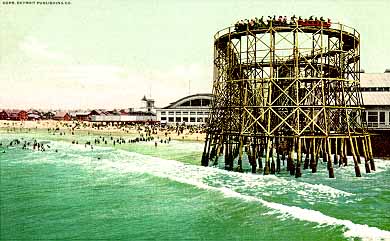
View inland from the pier of the Venice Scenic Railroad. - 1914
- Race Thru the Clouds (1911-1923)
- Type - Wooden Twin track Racer
- Location - On the Venice lagoon and canals - two blocks from beach
- Builder & Designer - John Miller design - Prior & Church operators
- Height - 90 feet
- Length - 4000 feet each side
The coaster was rebuilt in 1921 when deeper dips were added. Its enormous entrance facing Trolley Way was remodeled and included an ice cream parlor. It was torn down to make room for a proposed business district which was never built.
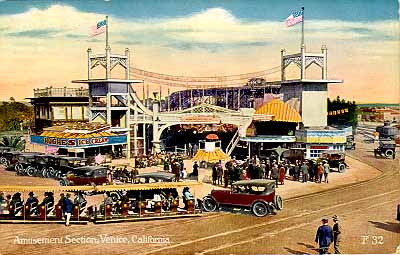
The entrance of the newly remodeled Race Thru the Clouds racing roller coaster. - 1921
- Big Dipper (1920-1923)
- Type - Wooden Out & Back
- Location - Abott Kinney Pier & Venice Amusement Pier
- Builder & Designer
- Height - 75 feet
- Length - 3200 feet
The Big Dipper was nearly the only ride to survive the Dec 20, 1920 pier fire.
- Bobs (1921- 1928)
- Type - Wooden Twister
- Location - Venice Amusement Pier
- Builder & Designer - Prior & Church
- Height - 60 feet
- Length - 2700 feet
The coaster's lift hill and first drop were in a darkened tunnel. It's three point suspension two passenger "Bobsled style cars with shorter wheel bases coupled in trains of nine cars, enabled it to negotiate sharp steeply banked turns. It was removed after Prior and Church broke up their partnership. Fred Church moved to the East Coast where he continued to design some of the greatest roller coasters of the time.
- Some Kick (1923-1934)
- Type - Wooden - Out & Back
- Location - Venice Amusement Pier
- Builder & Designer - Miller
- Height - 70 feet
- Length - 3500 feet?
Some Kick was dismantled in 1934, a victim of the bad economy of the Great Depression.
- Giant Dipper (1923-1946)
- Type - Wooden Twister (Bob's Design)
- Location - Venice Amusement Pier
- Builder & Designer - Prior & Church
- Height - 85 feet
- Length - 3300 feet (about 2 minutes)
The twister coaster was set in a figure eight pattern. It's first drop was at a 55 degree angle and its "Bobs" two passenger cars had a three point suspension that enabled it to negotiate tight turns.
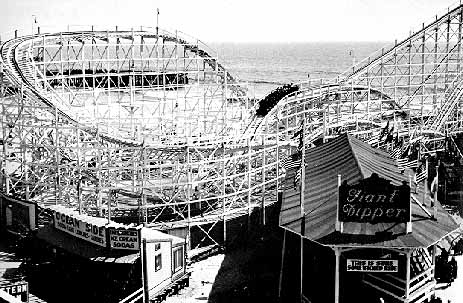
| The Giant Dipper replaced the Big Dipper roller coaster on the Venice Pier in 1924. |
Ocean Park Pier Area
- Ingersol Toboggan Railroad (1904-1910)
- Type - Wooden Figure 8
- Location - Adjacent to the Ocean Park Pier (extends into ocean)
- Builder & Designer - Ingersol
- Height - 30 to 35 feet
- Length - ????
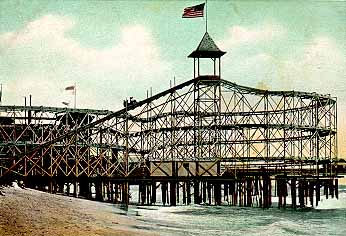
Ingersol's Scenic Railroad was the first roller coaster to be installed in the Venice / Ocean Park area. - 1904
- Dragon Gorge Scenic Railroad (1911-1912)
- Type - Wooden
- Location - On beach at the Fraser Million Dollar Pier
- Builder & Designer - L. A. Thompson Company
- Height - ???
- Length - ???
It burned in a pier fire on Sept 3, 1912.
- Grand Canyon Scenic Railroad (1911-1912)
- Type - Wooden - 3rd Rail Electric
- Location - Fraser Million Dollar Pier (extends into ocean)
- Builder & Designer - Paul Housch
- Height - ??
- Length - 4000 - 5000 feet??
This coaster had a 3rd rail to power the four car trains around curves and up steep inclines. A motorman controlled the car's speed and often added unexpected thrills by powering the ride down the hills, too! It burned in a pier fire on Sept 3, 1912.
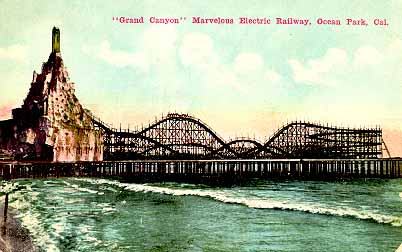
The Grand Canyon Electric Railroad was a scenic roller coaster powered by an electric third rail. - 1911
- Ben Hur Racer (1914-1915)
- Type - Wooden Dual Track Racer
- Location - Adjacent to Fraser Pier (extends into ocean)
- Builder & Designer - William Labb
- Height - 75 feet
- Length - 4200 feet
Half the coaster burned in a fire that destroyed 1/3 of pier. The owners did not half enough money to rebuild it.
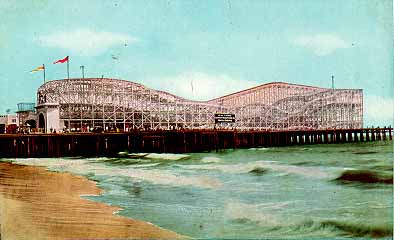
The Ben Hur Racer operated for just over a year before it burned in a pier fire. - 1914
- Blarney Racer (1920-1923)
- Type - Wooden Double Track Racer
- Location - Adjacent to Pickering Pier (extends into ocean)
- Builder & Designer - Page ? Crandall
- Height - 60 - 65 feet ?
- Length - 2800 - 3100 feet ?
Unfortunately the coaster was not a very fast ride. It never made its money back for Crandell.
- Zip (1922-1924)
- Type - Wooden Out and Back
- Location - Lick Pier
- Builder & Designer - Miller
- Height - 75 feet
- Length - 3500 feet ?
The coaster burned in a pier fire on Jan 6, 1924.
- Giant Dipper (1st) (1923-1924)
- Type - Wooden Twister
- Location - Adjacent Ocean Park Pier (extends into ocean)
- Builder & Designer - Prior & Church
- Height 85 feet
- Length 3300 feet?
Six months after it was built, it was destroyed by fire on Jan 6, 1924. Only the structure of the outer banked turn survived
- Giant Dipper (2nd) (1924-1931?)
- Type - Wooden Twister
- Location - Lick Pier
- Builder & Designer - Prior & Church
- Height - 85 feet
- Length - 3300 feet?
The Great Depression killed this coaster when the owner apparently went bankrupt.
- High Boy (aka Sea Serpent) (1926-1967)
- Type - Wooden Out & Back
- Location - Ocean Park Pier
- Builder & Designer - Miller / Page
- Height - 75 feet
- Length - 3300-3500 feet ??
The roller coaster was renamed the Sea Serpent to fit in with the park's marine theme when Pacific Ocean Park opened in July 1958. After the park closed in 1967, it was sold at auction to its new owners in Portland, Oregon. It was dismantled, but never rebuilt.
Hoppyland
- Little Dipper (1950-1954)
- Type - Wooden Junior Coaster
- Location - Hoppyland @ Washington Street & Dell (three blocks to beach)
- Builder & Designer - Philadelphia Toboggan Company(sold to L.A. Fairgrounds)
- Height - 35 feet
- Length - ????
Santa Monica Pier area
- Thompson Switchback Gravity Railroad (1887-1889)
- Type - Wooden
- Location - Across a canyon, one block from the beach
- Builder & Designer - LaMarcus Thompson
- Height 20-25 feet
- Length 300 feet ??
- Blue Streak Racer (1916-1924)
- Type - Wooden Dual Track Racer
- Location - Santa Monica Pier
- Builder & Designer - Page
- Height - 60 feet
- Length - 3500 feet each side
The roller coaster was purchased from the 1915 San Diego Exposition, dismantled and reconstructed on the Santa Monica Pier.
- Whirlwind Dipper (1924-1930)
- Type - Wooden Twister
- Location - Santa Monica Pier
- Builder & Designer - Prior & Church (Cost $75,000)
- Height - 80 feet
- Length - 3300 feet
Carousels
The carousel or merry-go-round has been a popular ride since it began appearing at traveling carnivals and parks in the 19th century. The earliest were steam and gasoline powered, but eventually when the cities obtained electric power, nearly all permanent site carousels of the 20th century were powered by electric motors and illuminated by thousands of colored lights.
Nearly all the well known carousel manufacturers were in the east; Dentzel & Philadelphia Toboggan Company (Philadelphia), Looff (Riverside, Rhode Island), Parker (Kansas) and Illions (Brooklyn, N.Y.). But in 1910, Charles Looff moved his family to Long Beach, California and expanded his factory there.
Looff built and operated carousels at Long Beach's Pike and, at Fraser's Million Dollar Pier in Ocean Park. In 1916 he decided to operate his own amusement pier and built one in Santa Monica, California.
Carousels were generic rides, bought and sold to other operators like any business. Sometimes they were moved from one amusement pier to another. While there was little innovation in the business, wood carving became an art form and many of the area's carousels showcased a variety of menagerie animals.
Prior and Church in 1917 patented the Great American Racing Derby, a horse racing carousel. First they increased the ride's diameter to 72 feet, then grouped the horses four abreast in ten distinct races. The horses, which were set in six foot long tracks, would move back and forth as the ride rotated. The ride accelerated until it reached nearly 30 MPH, then the bell would ring and the winner of each group would receive free repeat rides.
Carousels always remained popular through the decades. However, all carousel companies went bankrupt during the Depression when orders for new carousels ceased. As Venice's and Ocean Park's amusement piers closed, so did their carousels. Only Santa Monica's carousel remains in operation. It is ironic that all these throw-away rides that were often discarded are now worth a fortune since individual wooden horses and animals are now sell for $10,000 to $50,000 each at auction. Modern carousels mainly use fiberglass horses cast from molds of antique carousels.
Abott Kinney Pier (Venice)
- Dentzel (1915-1920) Menagerie machine that was originally located within the Ben Hur Racer on the nearby Fraser Pier. Burned in pier fire on Dec 20, 1920
- Racing Derby (1918-1920) Burned in the pier fire on Dec 20, 1920
Note: The Ocean Park Racing Derby was not moved to Venice. A much larger machine with a hundred foot diameter and 64 horses was set up beneath a tent. There was no inner carousel.
Venice Amusement Pier
- Parker #2 (1921-1924) Parker Superior Park - four abreast #2 was shipped to J.A. Ellis in September 1921. It was repossessed by the factory in 1924 when he failed to make payments. It was stored in Long Beach until 1927 when it was sold to a park at Jantzen Beach in Portland Oregon. It operates there today.
- Racing Derby (1921-1946) Sold to San Francisco Playland? (56 horses)
- Parker #142 (1928-1939) Relocated from the Fun Palace on the Ocean Park Pier and later sold to the owners of the Santa Monica Pier.
- PTC #62 (1942-1946) Purchased from a park in Tennessee. Moved to the Santa Monica Pier in 1947.
Hoppyland (Venice)
- E. Joy Morris (1951-1954) Menagerie machine built in 1902
Note: The pedigree of this carousel is in doubt. It may be an early PTC (Philadelphia Toboggan Co.) No one knows where the carousel operated previously to its installation at Hoppyland.
Fraser Million Dollar Pier (Ocean Park)
- Looff (1911-1912) Burned in pier fire Sept 3, 1912
- PTC #20 (1911-1912) Burned in pier fire Sept 3, 1912
Fraser / Pickering Pier (Ocean Park)
- Parker #142 (1913-1920) A three row Parker was operated by C.F. Townsend.
- Racing Derby (1917) (40 Parker horses) Sold to another amusement park.
Note: There might have been a standard Parker 62 animal carousel in the inner portion of the 72 foot diameter ride.
- Dentzel (1914) An elaborate carousel with menagerie animals was operated by J.A. Ellis within the Ben Hur Racer's structure along Ocean Front Walk. When the roller coaster's seaward end burned in a Christmas 1914 fire and not rebuilt the following spring, Ellis moved his carousel to the Abbot Kinney Pier.
- Dentzel (1920-1924) (72 menagerie animals) Burned in a spectacular pier fire on Jan 6, 1924.
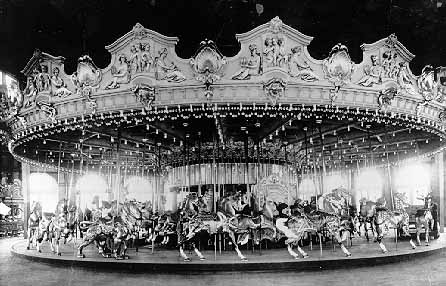
An elaborate Dentzel Carousel with menagerie animals was installed on the Pickering Pier. - 1920
Ocean Park Pier / Pacific Ocean Park
- Looff (1921-1967) (Built 1916) Sold to Portland Carousel Museum
- Parker #316 (1921-1928) A Parker carousel operated inside the Fun Palace fun house along Ocean Front Walk. It had an elaborate Wurltizer band organ. Moved first to Venice Pier in 1928 & later to Santa Monica Pier in 1939.
Santa Monica Pier
- Looff (1916-1939) Four abreast menagerie machine. Sold to San Diego's Mission Beach
- Parker #316 (1939-1947) Moved to pier from the Venice Pier
Note: Sold to Bradely's Beverly Park where it remained until 1974. Was in storage at Bradely & Kaye in Long Beach from 1974-1980. In 1980 restored to appear in Disney's movie "Something Wicked This Way Comes." From 1981-1985 operated at Calaway Park, Calgary, Alberta Canada. When the park went bankrupt that year its horses were sold.
- PTC # 62 (1947-Present) Moved to pier from the Venice Pier. Currently owned by the city of Santa Monica and is a National Historic Landmark.